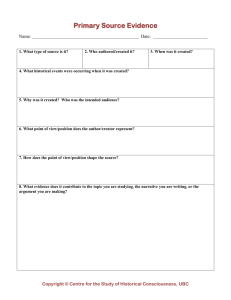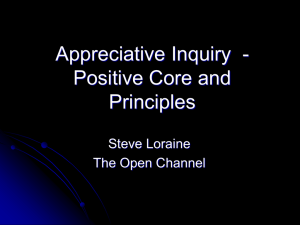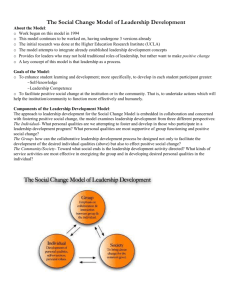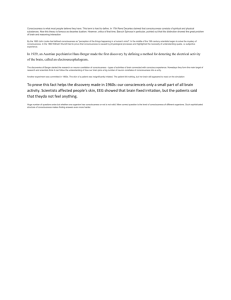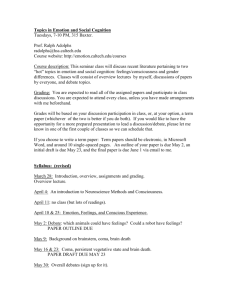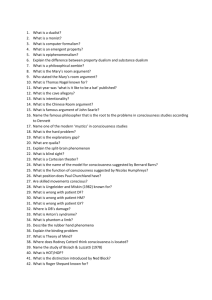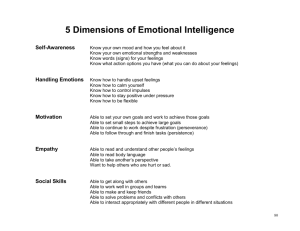Expanding Perceptions of Diversity: Diversity Consciousness and
advertisement
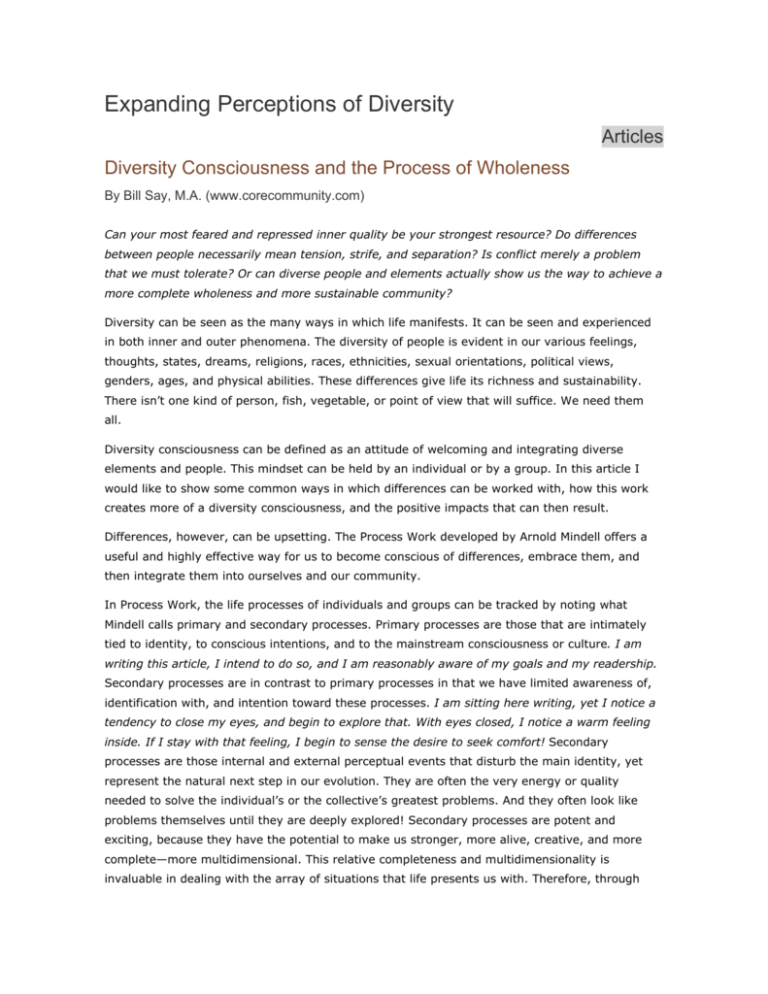
Expanding Perceptions of Diversity Articles Diversity Consciousness and the Process of Wholeness By Bill Say, M.A. (www.corecommunity.com) Can your most feared and repressed inner quality be your strongest resource? Do differences between people necessarily mean tension, strife, and separation? Is conflict merely a problem that we must tolerate? Or can diverse people and elements actually show us the way to achieve a more complete wholeness and more sustainable community? Diversity can be seen as the many ways in which life manifests. It can be seen and experienced in both inner and outer phenomena. The diversity of people is evident in our various feelings, thoughts, states, dreams, religions, races, ethnicities, sexual orientations, political views, genders, ages, and physical abilities. These differences give life its richness and sustainability. There isn’t one kind of person, fish, vegetable, or point of view that will suffice. We need them all. Diversity consciousness can be defined as an attitude of welcoming and integrating diverse elements and people. This mindset can be held by an individual or by a group. In this article I would like to show some common ways in which differences can be worked with, how this work creates more of a diversity consciousness, and the positive impacts that can then result. Differences, however, can be upsetting. The Process Work developed by Arnold Mindell offers a useful and highly effective way for us to become conscious of differences, embrace them, and then integrate them into ourselves and our community. In Process Work, the life processes of individuals and groups can be tracked by noting what Mindell calls primary and secondary processes. Primary processes are those that are intimately tied to identity, to conscious intentions, and to the mainstream consciousness or culture. I am writing this article, I intend to do so, and I am reasonably aware of my goals and my readership. Secondary processes are in contrast to primary processes in that we have limited awareness of, identification with, and intention toward these processes. I am sitting here writing, yet I notice a tendency to close my eyes, and begin to explore that. With eyes closed, I notice a warm feeling inside. If I stay with that feeling, I begin to sense the desire to seek comfort! Secondary processes are those internal and external perceptual events that disturb the main identity, yet represent the natural next step in our evolution. They are often the very energy or quality needed to solve the individual’s or the collective’s greatest problems. And they often look like problems themselves until they are deeply explored! Secondary processes are potent and exciting, because they have the potential to make us stronger, more alive, creative, and more complete—more multidimensional. This relative completeness and multidimensionality is invaluable in dealing with the array of situations that life presents us with. Therefore, through developing our diversity consciousness and working toward our wholeness, we are simply better able to live fully and sustainably. If we think of awareness as a “counting” process that, for example, counts sheep and simultaneously “discounts” dogs, there may be an identity at work that has tendencies to count certain things and discount others. These “others” will at some level then conflict with the main identity, the governing body. What are problematic or exciting are the elements we chronically discount, or marginalize. In individual and collective ways these “others” are seen as not “me,” or not “we.” I am/we are not angry, sexual, weak, powerful, mean, loving, etc. And yet, stunning growth is possible when I can begin to realize that the rejected quality or element is also a part of me, and furthermore is an energy that in its essence is something that I actually need in my life! Secondary processes are the mysterious, troubling elements that life invites us to integrate in order to become more whole. At an individual level, a person may experience troubling feelings that depart from her/his selfimage or identity. For example, a “peaceful” person may be troubled by angry feelings, yet ultimately find that the anger helps the individual stand up for her/himself and be direct. A “strong” person may be disturbed by “needy” or “weak” feelings, yet these same qualities can help him/her begin to make connections with others and feel less isolated. The secondary processes may be feelings, uncontrollable behaviors, addictions, attitudes, dreams, or movements of the body. These disturbing feelings or experiences can be avoided, or they can be embraced and integrated into a person’s being. They are, in fact, gifts. They are often solutions in the guise of trouble. Let’s look at some examples. “Joe” has chronic conflicts with powerful, abusive leaders. His identity/primary process is connected with being angry and oppressed, and under the influence of these leaders. The secondary process, the disturber in this instance, is the energy and quality of the abusive leader. It is an energy that keeps showing up in Joes’s life in the form of conflict that is asking to be noticed. Of course, Joe does not want to be abusive. Yet when he begins to explore some of the essential qualities of this energy, he discovers a directness, an assertive quality that had previously been missing from his life. The “leader” is ultimately revealed to be the energy, the quality, and the role that Joe needs to recognize in himself and integrate to fulfill an important part of his evolution. In romantic relationships, the secondary process is often reflected in the energy, behavior, and role of one’s mate. “Sue” experiences “Bob” as overly dependent and needy. “Bob” experiences “Sue” as unavailable (or substitute assertive/passive, sexually interested/disinterested, talkative/taciturn, etc.). This polarity can easily result in a chronic low-grade (or high-grade) conflict. Each “forgets” that she/he too has this quality or part, and instead is bothered by this trait in the partner. In the situation with “Bob” and “Sue,” a therapist can support them by helping each in “remembering” the quality of the other, and even switching roles. “Bob” begins to find his own independent nature, and “Sue” expresses more of her dependence and need. Their conflict can begin to dissipate, and they can experience greater fulfillment by integrating these energies. Collective situations such as families, communities, or organizations have natural, evolutionary movements that can become blocked. What is needed for evolution, to become more whole, is often first perceived as troubling. What is troubled is the mainstream body: its perspectives, ways of doing things, and status quo. New or “foreign” elements, processes, or people can be perceived as upsetting to the mainstream norm. Conflict is a common result, and too often the new “other” is relegated to a lesser or minority role. Yet this “other” often holds the key to the group’s forward movement and growth, and often to its main problem. A family with extremely stormy, intrusive, and even abusive tendencies has a boy who tends toward depression and withdrawal. He has an accident and lapses into a coma and then into a prolonged vegetative state. This child shows extremely little response to any of his visiting family members. A therapist, skilled in following life processes, notices the minimal responses of the child, the sense that he is in withdrawal, and actually insulated. He offers the gentle suggestion to the boy that he respect his own need to go inward, to be away from everyone. This comment elicits a smile from the boy and then tears. Here, the disturbing nature of a family member in a vegetative state can simply remain a troubling fact of life. Or his very state and process of going inward can be seen as a vital process that the whole family needs. They also need to be more circumspect, less reactive, and respectful of each others’ boundaries. The very process this boy exhibits is what is needed generally in his family. And perhaps it is what this family needs to recognize and to integrate in order for the boy to have any hope or wish of returning home. An organization that prides itself on being open-minded and liberal finds its leadership being angrily accused of bias (for example, sexism, racism, etc.) by one of its members. They cannot understand this accusation, and defensively deny the charge. This member comes up with angry yet vague examples of their bias. Eventually, she bitterly leaves the organization. The leaders are troubled, cannot understand what has occurred, and start to find that important customers are leaving, looking elsewhere for the services this organization provides. Wisely, the leaders intuit that these departures are somehow connected. Threatened and disturbed, they begin to hold meetings to explore what is happening. What they gradually find in their leadership is a tendency to hold power over others, be subtly biased against people, and even exert a force that threatens employees into silent compliance. This is of course troubling, and yet when these tendencies are brought out in the open, a significant shift occurs in the atmosphere of this organization. Conflicts are now more overt; members begin commenting on how they are starting to feel safer in this environment, and how they are freer in expressing things that they previously would have withheld. And then, in a meaningful sense for some, a former client returns to engage this organization’s services. The woman who was initially seen as the critic became the inspiration for important changes. Diversity consciousness can be defined as the ongoing process of identifying, contacting, and integrating “foreign” or different parts of self and others. This can happen as in the above examples where an individual or group finds a part, an “other,” and initially marginalizes it but then integrates it. Diversity consciousness, again, also implies an attitude that seeks greater wholeness by welcoming and integrating diverse elements and people. This consciousness does so by integrating elements that initially appear as an “other” but are then discovered to be part of itself. Diversity consciousness has major repercussions for the sustainability and vitality of individuals, relationships of all kinds, and collectives. Without this tendency toward integration and wholeness, and integrating “others,” the individual or collective stays limited. In the extreme, we “kill” off “others” either literally or figuratively. We can do so all the more easily because we can see the “other” as not “me” or not “we.” So, we repress important parts of the self. And we as people have quite a tendency to kill off others whom we see as the “other,” as some form of enemy. We also effectively forget about, ignore, or repress whole groups of people because “we” see that “they” are not “us.” In both individual and collective situations, wholeness is compromised with the marginalization of “others.” And wholeness can be equated with sustainability. For example, the sustainability of our agricultural system cannot be secured by focusing on a few varieties of plants. Such a narrowing makes the few susceptible to conditions that could wipe them out. Likewise, an individual will be vulnerable to challenging life conditions if that individual is too rigid in his or her mindset. Life needs all of its components; and life needs all of us. I invite you now to try the following exercise that will help you experience, on a practical level, what diversity consciousness feels like. Bring to mind someone with whom you feel disturbed. Notice your feelings. Then try to define the energy or quality of this person that really bothers you. Maybe it is the person’s aggressiveness, weakness, self-centeredness, etc. Try to distill this quality down to one characteristic. Then shift; see if you can fully embody this quality or energy. Of course, seeing the positive in qualities like aggression, passivity, etc., is difficult. See if you can suspend judgment and allow an exploration of this quality. What is good and helpful about this quality, perhaps not in its surface manifestation, but in its essence? Really step into it and see how you feel, think, speak, and how you move your body or simply your hands. Try making very full movements and then more subtle slow ones. Take your time and go fully into the slow movements and feelings in this quality. By feeling and sensing carefully you may begin to notice an essential quality that is quite different from the overt expression. As you do, consider how you may need this energy, this essence, even more in your life. What does it teach you? How could you bring it into your life? How does it make you more whole? Does it shift the feeling you have with this person? We’ve all heard the saying, “What we hate most in others is what we hate most in ourselves.” In the context of diversity consciousness, I would restate this as, “What we hate or fear most in others is what we most need in ourselves.” I hope you have found this article meaningful and useful. I am dreaming of a world where there is a place for everyone and all of life. Let’s dream and live this together. Thank you.
